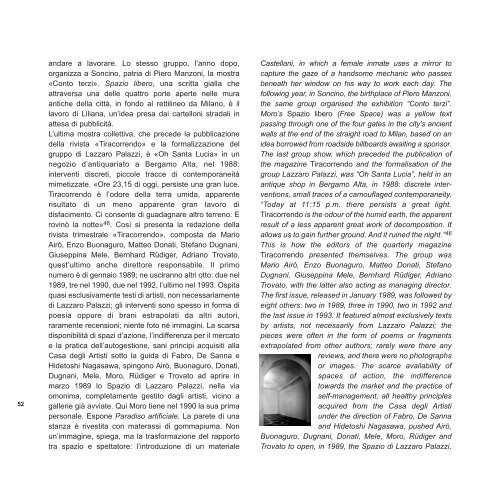Adachiara Zevi - arteinmemoria
Adachiara Zevi - arteinmemoria
Adachiara Zevi - arteinmemoria
Create successful ePaper yourself
Turn your PDF publications into a flip-book with our unique Google optimized e-Paper software.
52<br />
andare a lavorare. Lo stesso gruppo, l’anno dopo,<br />
organizza a Soncino, patria di Piero Manzoni, la mostra<br />
«Conto terzi». Spazio libero, una scritta gialla che<br />
attraversa una delle quattro porte aperte nelle mura<br />
antiche della città, in fondo al rettilineo da Milano, è il<br />
lavoro di Liliana, un’idea presa dai cartelloni stradali in<br />
attesa di pubblicità.<br />
L’ultima mostra collettiva, che precede la pubblicazione<br />
della rivista «Tiracorrendo» e la formalizzazione del<br />
gruppo di Lazzaro Palazzi, è «Oh Santa Lucia» in un<br />
negozio d’antiquariato a Bergamo Alta, nel 1988:<br />
interventi discreti, piccole tracce di contemporaneità<br />
mimetizzate. «Ore 23,15 di oggi, persiste una gran luce.<br />
Tiracorrendo è l’odore della terra umida, apparente<br />
risultato di un meno apparente gran lavoro di<br />
disfacimento. Ci consente di guadagnare altro terreno. E<br />
rovinò la notte» 46 . Cosí si presenta la redazione della<br />
rivista trimestrale «Tiracorrendo», composta da Mario<br />
Airò, Enzo Buonaguro, Matteo Donati, Stefano Dugnani,<br />
Giuseppina Mele, Bernhard Rüdiger, Adriano Trovato,<br />
quest’ultimo anche direttore responsabile. Il primo<br />
numero è di gennaio 1989; ne usciranno altri otto: due nel<br />
1989, tre nel 1990, due nel 1992, l’ultimo nel 1993. Ospita<br />
quasi esclusivamente testi di artisti, non necessariamente<br />
di Lazzaro Palazzi; gli interventi sono spesso in forma di<br />
poesia oppure di brani estrapolati da altri autori,<br />
raramente recensioni; niente foto né immagini. La scarsa<br />
disponibilità di spazi d’azione, l’indifferenza per il mercato<br />
e la pratica dell’autogestione, sani principi acquisiti alla<br />
Casa degli Artisti sotto la guida di Fabro, De Sanna e<br />
Hidetoshi Nagasawa, spingono Airò, Buonaguro, Donati,<br />
Dugnani, Mele, Moro, Rüdiger e Trovato ad aprire in<br />
marzo 1989 lo Spazio di Lazzaro Palazzi, nella via<br />
omonima, completamente gestito dagli artisti, vicino a<br />
gallerie già avviate. Qui Moro tiene nel 1990 la sua prima<br />
personale. Espone Paradiso artificiale. La parete di una<br />
stanza è rivestita con materassi di gommapiuma. Non<br />
un’immagine, spiega, ma la trasformazione del rapporto<br />
tra spazio e spettatore: l’introduzione di un materiale<br />
Castellani, in which a female inmate uses a mirror to<br />
capture the gaze of a handsome mechanic who passes<br />
beneath her window on his way to work each day. The<br />
following year, in Soncino, the birthplace of Piero Manzoni,<br />
the same group organised the exhibition “Conto terzi”.<br />
Moro’s Spazio libero (Free Space) was a yellow text<br />
passing through one of the four gates in the city’s ancient<br />
walls at the end of the straight road to Milan, based on an<br />
idea borrowed from roadside billboards awaiting a sponsor.<br />
The last group show, which preceded the publication of<br />
the magazine Tiracorrendo and the formalisation of the<br />
group Lazzaro Palazzi, was “Oh Santa Lucia”, held in an<br />
antique shop in Bergamo Alta, in 1988: discrete interventions,<br />
small traces of a camouflaged contemporaneity.<br />
“Today at 11:15 p.m. there persists a great light.<br />
Tiracorrendo is the odour of the humid earth, the apparent<br />
result of a less apparent great work of decomposition. It<br />
allows us to gain further ground. And it ruined the night.” 46<br />
This is how the editors of the quarterly magazine<br />
Tiracorrendo presented themselves. The group was<br />
Mario Airò, Enzo Buonaguro, Matteo Donati, Stefano<br />
Dugnani, Giuseppina Mele, Bernhard Rüdiger, Adriano<br />
Trovato, with the latter also acting as managing director.<br />
The first issue, released in January 1989, was followed by<br />
eight others: two in 1989, three in 1990, two in 1992 and<br />
the last issue in 1993. It featured almost exclusively texts<br />
by artists, not necessarily from Lazzaro Palazzi; the<br />
pieces were often in the form of poems or fragments<br />
extrapolated from other authors; rarely were there any<br />
reviews, and there were no photographs<br />
or images. The scarce availability of<br />
spaces of action, the indifference<br />
towards the market and the practice of<br />
self-management, all healthy principles<br />
acquired from the Casa degli Artisti<br />
under the direction of Fabro, De Sanna<br />
and Hidetoshi Nagasawa, pushed Airò,<br />
Buonaguro, Dugnani, Donati, Mele, Moro, Rüdiger and<br />
Trovato to open, in 1989, the Spazio di Lazzaro Palazzi,


